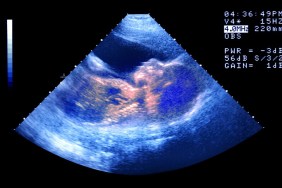Everyone knows that there can be more risk involved with pregnancies involving multiples, but you may be less familiar with a rare disorder called Twin to Twin Transfusion Syndrome (TTTS), which can occur in identical twin (or higher multiples) pregnancies sharing the same placenta. If you are pregnant with identical twins, here is what you need to know about Twin to Twin Transfusion Syndrome.
Simply put, Twin to Twin Transfusion Syndrome is a disease of the placenta. When identical twins share one placenta (monochorionic twins), it is sometimes possible for abnormal blood vessels to connect the umbilical cords and circulatory systems of the twins. Due to these abnormal connections, blood isn’t always distributed evenly between the two babies—meaning one baby may receive too much blood flow, whereas the other will not get enough. Although the twin receiving less blood (the donor) is at risk for anemia, dehydration, and developmental delays, the twin getting more blood (the recipient) is also at risk for problems such as high blood pressure, heart failure, respiratory and digestive issues, brain defects, and he may overflow the amniotic sac with urine. TTTS can be fatal to either or both twins.
When can TTTS be detected?
It is possible for this condition to arise at any point during pregnancy, as early as 12 weeks or as late as scheduled labor.
Is Twin to Twin Transfusion Syndrome common?
Of the 25 percent of twins who share a placenta, roughly 10 percent of those pregnancies end up with this disorder.
What are the symptoms of Twin to Twin Transfusion Syndrome?
Although often unrecognizable, there are signs that may alert the mother of abnormality. For instance, have you experienced unusually quick belly growth (sometimes coupled with abrupt weight gain), or is your uterus measuring larger than usual? Additionally, if you are experiencing pain, tightness or contractions (early in pregnancy), or early-onset edema (swelling of the hands and feet), this could be signs.
How is TTTS diagnosed?
If you are pregnant with twins, the first step is detecting whether they share a placenta. If so, your doctor may schedule a nuchal translucency test, which can sometimes show early signs of TTTS. During an ultrasound, your healthcare provider may also notice a distinct difference in the babies sizes/weights, or a distinct size difference between the two amniotic sacs or umbilical cords. There may be excess amniotic fluid (in the recipient) or a lack thereof (in the donor), as well as signs of fluid build up in the skin of either twin.
Is there any treatment for TTTS?
Early detection is key. Once diagnosed, all cases will be continually monitored throughout the remainder of the pregnancy. Doctors may suggest draining excess fluid from the recipient-twin’s amniotic sac in order to help even out the blood flow (amnioreduction). For more severe cases, doctors may recommend early delivery or laser treatment, called fetoscopic laser photocoagulation. During the surgery, a small incision is made so that a tiny telescope can be inserted into the uterus to see all the blood vessel connections, at which point the surgeon will seal shut the abnormal connections in order to disconnect the babies blood flow from one another.
Am I at risk for Twin to Twin Transfusion Syndrome?
Twin to Twin Transfusion syndrome is rare and random, and anyone pregnant with identical twins sharing a placenta is at risk. It is not the fault of the mother or the babies, nor is it hereditary or genetic. If you had TTTS with a previous pregnancy, you are equally at risk during subsequent placenta-sharing pregnancies. Remember, only identical twins (or greater multiples) sharing a placenta are at risk. Fraternal twins (dichorionic) with individual placentas, or identical twins with separate placentas that fuse together, are not at risk.
Can I prevent TTTS?
Unfortunately, there is no way to stop TTTS from occurring.
The most important thing is to find out if you have Twin to Twin Transfusion Syndrome. Once you’ve been given the good news of your twin pregnancy, find out if the babies share a placenta, and ask your doctor if you might be at risk for TTTS. The earlier you know, the more options you’ll have. Find more answers and support on the Twin to Twin Transfusion Syndrom Foundation website.
More on Twins & Pregnancy:
7 Truths About Identical Twins
First Trimester Tests During Pregnancy: Everything You Need To Know
8 Obstacles I Faced & Overcame During My Pregnancy
Photo: Getty








